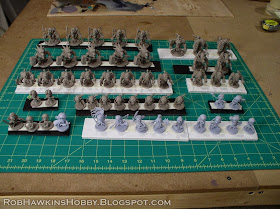Galleries
▼
Wednesday, July 30, 2014
Friday, July 25, 2014
Doom Wheel
Now that a huge chunk of work is out of the way, I've got some time to work on a couple personal projects. My Vampire Counts and Skaven painting queues are both pretty full, but since I'm in the middle of a campaign with my Skaven, they're the ones that get the attention for now.
Speaking of the campaign, we've been on hiatus for a couple of months. between people getting sick, and conflicting work schedules none of us had any time to meet and play games. But we're back up and running, so I'll have an update soon.
First up on the list of new Skaven is my second Doom Wheel. This was converted with unused parts from the plastic Warp Lightning Cannon/ Plague Claw Catapult kit.
Next I'll be tackling the Hell Pit Abomination. After that I have the Plague Claw Catapult and a ton of new Plague Monks to attend to.
'Til next time!
Wednesday, July 16, 2014
Zombie Pirates
A reader contacted me recently, asking about some models he'd seen in an old White Dwarf supplement featuring zombie pirates. The issue in question was #306, and it had an army list for the Zombie Pirates of the Vampire Coast. When I was working for GW's US promotions studio, we were tasked with inventing some ideas for the zombie pirate units and modeling up conversions to be photographed for the magazine. I've held onto the models all these years.
Thanks to Remi Oliveras for getting me to dust these guys off and take some proper detail shots. Enjoy!
Fleet Captain
The zombie pirate army is led by the vampire Luthor Harkon, but his captains are similar to wight kings. This ancient mariner was modeled up with an albatross around his neck, and leads his crew from their watery grave.
The base model is the Red Gobbo. I clipped away most of the model so only the coat and left hand remain. The captain's right hand and pistol are from the Regiment of Reknown, Long Drong Slayer's Pirates and the cutlass is from a plastic Talisman miniature. I think the legs are from a Kislev Kossar. I used a plastic Tomb Kings skull with a sculpted eye patch and the Mordheim Highwayman's hat. The treasure chest is an ammo case from the Dogs of War regiment Bronzino's Galloper Guns. His albatross (a falcon from the Wood Elf Skaw the Falconer) adds a characterful detail and helps hide the 40K bits and leg join underneath.
Deck Gunners
These were inspired by the Skaven two-man weapon teams. The zombie crewmen are armed with small swivel guns, which they would normally fire from the deck of the ship, but occasionally take ashore in a landing party.
Most of the parts are from the plastic zombie kit, mixed with the old Empire Free Company regiment. The hats are from the old Halfling infantry models (specifically Halfling with Spear #2) and the Mordheim Highwayman. A lot of the spare pistols are from Long Drong Slayer's. It took some digging on the Stuff of Legends site to find it, but I think the orcy-looking zombie on the far left was made from the model "Kand-Meet" from Citadel's 1986 zombie range. It's just his head and torso, with a Highwayman's hat on his head. The two small swivel guns are Implacable Steam Tank pivot guns and the larger is one is a cannon from Bronzino's Galloper Guns.


















































